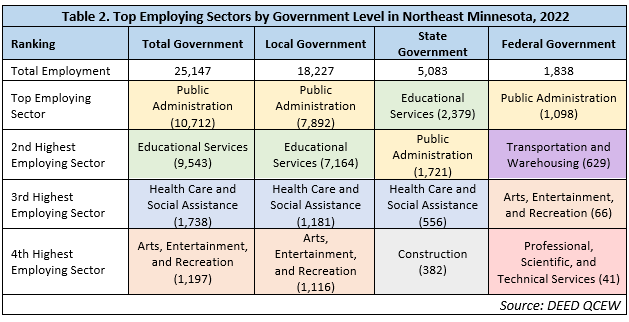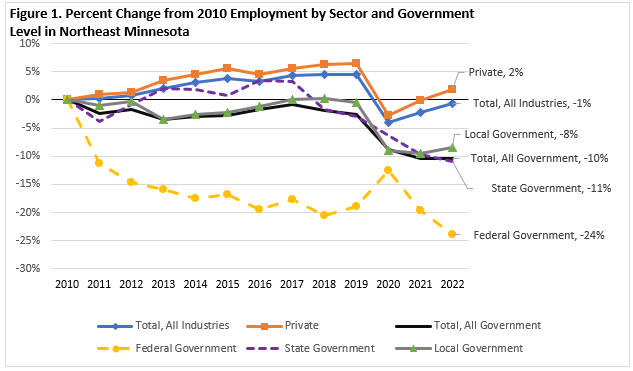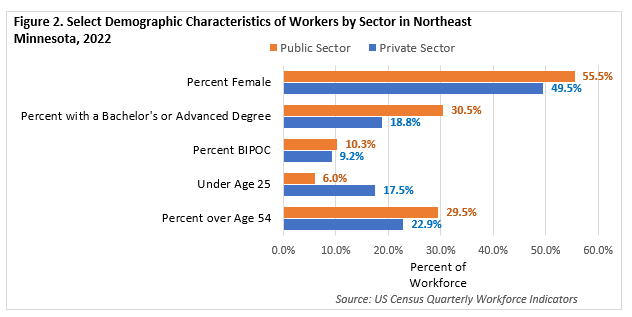by Carson Gorecki
July 2023
Government jobs play an outsize role in Greater Minnesota's economy. They pay above average wages and are relatively more concentrated outside of the Twin Cities Metro. Even as the Minneapolis-St. Paul region accounts for more than 53% of all government jobs, the public sector accounts for a larger share of total employment in the rest of the state, including Northeast Minnesota. Public Sector jobs accounted for 13% of Minnesota's employment in 2022. In Northeast Minnesota government jobs represented 18.4% of employment, trailing only Northwest Minnesota's 20.4%, as a share of total employment by region.
Of the 136,500 jobs in Northeast Minnesota, over 25,000 were in the public sector as of 2022 (see Table 1). Most government jobs in Northeast Minnesota and across the state are at the local level. Statewide, local government jobs accounted for 70% of all government jobs. In Northeast Minnesota the local government share is a slightly higher 72.5%, but reached as high as 90.1% in Aitkin County and as low as 68.3% in Saint Louis County.
A higher local government share means that the state and federal shares in the region were lower than the statewide averages of 8.6% and 21.5% respectively. However, there was significant variability in federal and state employment shares across the region. Carlton, Lake, and Saint Louis counties had above average shares of state government employment while Cook, Aitkin, and Koochiching all had less than a third of the statewide average. Conversely, Carlton and Lake counties had the lowest federal employment shares while Cook and Koochiching counties' shares were more than double the statewide average.
| Table 1. Number and Distribution of Public Sector Jobs by Government Level and Area, 2022 | ||||||||
|---|---|---|---|---|---|---|---|---|
| Sector or Government Level | Northeast Minnesota | Aitkin | Carlton | Cook | Itasca | Koochiching | Lake | St. Louis |
| Total All Government Jobs | 25,148 | 828 | 4,358 | 778 | 3,127 | 887 | 863 | 14,304 |
| Federal Gov. Share | 7.3% | 4.7% | 1.4% | 17.2% | 5.0% | 19.5% | 2.3% | 8.8% |
| State Gov. Share | 20.2% | 5.2% | 23.8% | 2.8% | 14.5% | 7.0% | 22.0% | 22.9% |
| Local Gov. Share | 72.5% | 90.1% | 74.8% | 80.1% | 80.5% | 73.4% | 75.7% | 68.3% |
| Public Admin. Share* | 42.6% | 39.9% | 46.6% | 49.9% | 38.9% | 49.8% | 43.1% | 41.4% |
| Tribal Gov. Share | 5.0% | n/a | 20.8% | 13.9% | n/a | n/a | n/a | 1.6% |
| *Public Administration sector consists of gov. agencies that administer and manage public programs and have executive, legislative, or judicial authority over other institutions in a given area. The sector does not include the operation of many governmental programs which are categorized by the specific activities performed thereby. Source: DEED Quarterly Census of Employment and Wages | ||||||||
Public Administration is an industry sector under the North American Industry Classification System (NAICS) that consists of only public sector employment, but does not include all public sector employment. Public Administration entities typically are focused on the management and administration of activities as opposed to the operations performed by governmental entities. Those offices and departments of governments that perform specific operations or delivery of services are categorized under the applicable sector. By example, the Duluth City Mayor's Office's staff would fall under Public Administration, but the Duluth Transit Authority's employees would count under the Transportation and Warehousing sector, and most employees of the Duluth School District would fall under Educational Services.
The Public Administration sector accounts for just over two out of every five government jobs in Northeast Minnesota. The next largest share of public sector employees belongs to the Educational Services sector with 9,543 government workers (37.9%), followed by Health Care & Social Assistance (6.9%), Arts, Entertainment & Recreation (4.8%), and Transportation & Warehousing (2.9%). Combined, those five sectors encompass over 95% of public sector employment in the region (see Table 2).
The distribution of public employment by sector varies slightly depending on the level of government. Public Administration is the sector with the most local and federal employees, and the second most state government employees. Educational Services takes the largest share of state government workers in the region and the second most local government workers. The second place spot in federal employment fell to Transportation & Warehousing, which accounted for 57.3% of jobs. After Health Care & Social Assistance, the Arts, Entertainment & Recreation sector took the third and fourth spots for federal and local government respectively. Those jobs consist primarily of Gambling Industries (986 jobs) at the local level and is entirely Other Amusement & Recreation Industries employment at the federal level.

The 2023 state legislative session included the expansion of many current state programs as well as the creation of new initiatives such as the Office of Cannabis Management and the Department of Children and Families. As a result, additional state employees will be needed to staff the new offices and administer the new or expanded programs effectively. Most of these new jobs will be in the Twin Cities Metro, where most state agency headquarters are. An increase in public employees, however, will likely impact the rest of the state as well, especially with the rise of remote work. As of 2022, state and federal government jobs were slightly more concentrated inside the metro, but local government employment was 1.32 times more concentrated in Greater Minnesota. In Northeast Minnesota all three levels of government were more concentrated, particularly local government, which was 1.84 times the metro share of employment.
Since 2010 the total number of government jobs in Northeast Minnesota fell by just over 2,900, a decline of 10.3% (see Figure 1). By comparison, total employment across all sectors declined by 906 jobs, or -0.7%. The difference is that private sector employment grew by nearly 2,000 jobs or 1.8%. The drop in government employment until 2019 was driven by large losses in federal jobs in the region. Federal employment fell by nearly 20% from 2010-2019, accounting for two-thirds of the total government jobs lost over nine years.
More recently, total government jobs declined by 2,172 in the region from 2019-2022, a decrease of 8%. Unlike earlier in the decade, it was local (8.1%) and state (8.2%) government employment that declined at faster rates. Government employment losses accounted for 30% of all job losses over the three-year period, despite representing less than 20% of overall employment. Local government losses (-1,597 jobs) alone accounted for 22.3% of the overall employment decline.

Within local government, the largest employment losses since 2019 occurred in Arts, Entertainment & Recreation (532 jobs), Health Care & Social Assistance (362), Public Administration (248), and Educational Services (213). Among those four sectors, Arts, Entertainment & Recreation (32.3%) and Health Care & Social Assistance (23.5%) saw the largest percent employment declines. Transportation & Warehousing, while a smaller share of total local government employment, also saw a larger relative decline (32.3%). Public Administration (3.0%) and Educational Services (2.9%) appear to have been more insulated from the impacts of the pandemic and thus had smaller declines. By contrast, state government Educational Services employment fell 9.9% or 262 jobs. State Public Administration employment (5.8%) also fell relatively faster than the local counterparts while Health Care & Social Assistance (-12.3%) and Arts, Entertainment & Recreation (12.5%) at the state level fared relatively better.
Public sector jobs on average pay higher wages than private sector jobs in the region. In 2022 the average wage for government jobs in Northeast Minnesota was $56,680, and the private sector average was $54,236. Recent wage trends, however, mean that the gap between private and public sector wages is closing. Since 2020 wages for all private jobs in the region rose 11.7%. For all government jobs the average increase was a lower 6.5%. In 2009 the government-to-private wage ratio was 1.19. By 2022 the pay differential had shrunk to 1.05, as wages rose faster in the private sector. Benefits are also a large component of compensation. According to national data from the Bureau of Labor Statistics' Employment Cost Index, the value of benefits compensation is higher relative to benefits provided by private employers and has weathered the impacts of inflation better than wages. The value of benefits paid to state and local government workers was about the same in 2022 (1.17) as in 2019 (1.16) and was up from 2009 (1.07).
Sticking with the wage data for which there is good local detail, there are some notable differences by industry sector. For example, public employees working in Arts, Entertainment & Recreation have a notable wage advantage ($18,200 per year) over their private counterparts in the same industry (see Table 3). The same is true for the other half of Leisure & Hospitality: Accommodation & Food Services, which pays an average wage that is 25% higher than private workers receive. Educational Services, in addition to employing five times as many employees as private institutions, also pays higher wages, to the tune of about $14,500 per year.
At the other end of the spectrum, the largest relative disparity in pay lay in Wholesale Trade, for which public employees received wages equal to only 62% of private workers in the industry. Low public employment in that industry limits any potential conclusions. Utilities, with over 120 jobs, paid 66%, and Administrative Support & Waste Management Services paid 70% of their respective private averages.
| Table 3. Average Annual Wage by Industry and Sector in Northeast Minnesota, 2022 | |||
|---|---|---|---|
| Industry | Government Employment | Government Average Wage | Private Average Wage |
| Professional, Scientific, and Technical Services | 52 | $72,072 | $75,036 |
| Utilities | 124 | $71,552 | $108,108 |
| Transportation and Warehousing | 739 | $66,040 | $59,696 |
| Construction | 468 | $65,936 | $72,904 |
| Health Care and Social Assistance | 1,738 | $63,492 | $60,788 |
| Public Administration | 10,712 | $59,956 | n/a |
| Total, All Industries | 25,148 | $56,680 | $54,236 |
| Information | 36 | $54,600 | $50,336 |
| Educational Services | 9,543 | $54,236 | $39,780 |
| Finance and Insurance | 3 | $53,924 | $75,400 |
| Wholesale Trade | 7 | $43,524 | $70,096 |
| Arts, Entertainment, and Recreation | 1,197 | $40,456 | $22,256 |
| Real Estate and Rental and Leasing | 24 | $35,048 | $39,364 |
| Accommodation and Food Services | 155 | $26,624 | $21,216 |
| Retail Trade | 20 | $25,792 | $32,916 |
| Administrative Support and Waste Management Services | 327 | $25,220 | $36,296 |
| Source: DEED Quarterly Census of Employment and Wages | |||
Compared to the private sector, the public sector workforce of Northeast Minnesota is older, more racially and ethnically diverse, more female, and more educated. Whereas 22.9% of privately employed workers were 55 years or older, that share was 29.5% for public sector workers. An even larger disparity lay at the young end of the age distribution. Eighteen percent of private workers were under 25 compared to 6% of government employees (see Figure 2). Younger workers are less likely to work in the public sector because of the requirements of many government positions.
Related to age is educational attainment. Public sector workers were more likely to have a Bachelor's or more advanced degree than workers in the private sector by a count of 30.5% to 18.8%. The share of workers with some college or associate's degree (33.9%) was also slightly higher than in the private sector while the share of workers with a high school diploma or less (29.7%) was slightly lower. The public sector had a much smaller share of its workforce for which educational attainment was not available (under 24 years of age), reflecting the prevalence of older workers in the sector.
Government employees are also more likely to be female than private workers. 55.5% of government workers in 2022 identified as female, compared with 49.5% of employees in the private sector. The higher share of women is related to the concentration of government jobs in Health Care and Educational Services. 66.5% of public workers in Educational Services and 71.3% in Health Care identified as female in 2022. Workers in Public Administration, however, were more likely to be male (56%/44%).

Public employees in Northeast Minnesota were also more likely to be BIPOC than in the private sector, albeit by a slight margin. The 10.3% of government workers who identified as people of color was above the 9.2% of the private sector as well as the 8.9% of the total population. Within the regional public sector workforce, the largest group of color was American Indians or Alaska Natives (4.9%). Northeast Minnesota is the ancestral home of many indigenous peoples and is the current home of four tribal nations. Tribal communities have their own governments, increasing the overall diversity of the regional public sector workforce. Relatedly, 7.8% of the Public Administration workforce is American Indian or Alaska Native. Statewide, where tribal governments are less concentrated, the public sector workforce is less diverse than the private workforce by a measure of 14.5% to 21.2%.
Reflecting the high share of government jobs in Educational Services industries, the top three most common public sector occupations were Teaching Assistants, Elementary School Teachers, and Secondary School Teachers. Together those three occupations alone accounted for nearly 17% of government jobs (see Table 4). If Educational Services are removed, the most common occupations become Police & Sheriff's Patrol Officers, Court, Municipal & License Clerks, Firefighters, and Project Management Specialists and Business Operations Specialists. Correctional Officers, Maintenance Workers, Registered Nurses, and Social Workers were also were among the top occupations. Six of the top 10 most common public sector occupations paid wages above the regional median.
| Table 4. Employment and Wage Statistics for Top Public Sector Occupations, 2023 | |||
|---|---|---|---|
| Occupation | Share of Total Employment | Share of Government Employment | Northeast Minnesota Median Annual Wage |
| Teaching Assistants, Except Postsecondary | 1.2% | 7.1% | $38,110 |
| Elementary School Teachers, Except Special Education | 0.8% | 5.4% | $62,554 |
| Secondary School Teachers, Except Special and Career/Technical Education | 0.6% | 4.4% | $64,162 |
| Police and Sheriff's Patrol Officers | 0.4% | 3.0% | $69,705 |
| Project Management Specialists and Business Operations Specialists, All Other | 1.1% | 2.4% | $88,309 |
| Court, Municipal, and License Clerks | 0.3% | 2.3% | $51,231 |
| Janitors and Cleaners, Except Maids and Housekeeping Cleaners | 1.4% | 2.2% | $34,993 |
| Secretaries and Admin. Assistants, Except Legal, Medical, and Executive | 1.2% | 2.0% | $44,341 |
| Middle School Teachers, Except Special and Career/Technical Education | 0.3% | 2.0% | $62,545 |
| Firefighters | 0.2% | 1.9% | $46,334 |
| Registered Nurses | 2.4% | 1.6% | $78,892 |
| Correctional Officers and Jailers | 0.2% | 1.4% | $56,112 |
| Highway Maintenance Workers | 0.2% | 1.4% | $57,723 |
| Maintenance and Repair Workers, General | 0.8% | 1.3% | $51,214 |
| Child, Family, and School Social Workers | 0.3% | 1.3% | $66,072 |
| Office Clerks, General | 1.7% | 1.3% | $40,727 |
| Source: MN Occupational Employment and Wage Statistics | |||
The next several years for government employment in Greater Minnesota will be interesting to follow. How the staffing increases predicted to occur with new or expanded state programs will impact Northeast Minnesota is still unknown. If Northeast Minnesota is the recipient of increased government positions, they are likely to be jobs that pay above average wages and offer more benefits. Workers in public sector jobs are more likely to remain in their positions for longer than those in the private sector, indicating greater job satisfaction and security. In fact, the median tenure for government workers of 6.8 years was almost twice as long as that for all private sector workers (3.7 years). No major private industry sector had tenure longer than that of federal, state, or local employees. Lastly, increases in public sector jobs will potentially offset the government employment losses of the last three years.